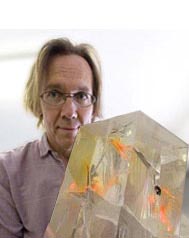About LANL
About Our Capabilities, Facilities, and Staff
"Los Alamos National Laboratory plays an indispensable role in building America as a science and technology powerhouse, and our staff are an incredible resource to the nation and the world." Michael Anastasio, Dir.
Solving Complex R&D Problems with Special Blend of Staff, Capabilities and Facilities
Now in its seventh decade, LANL remains among a very few laboratories that can bring great breadth of fundamental and discovery science, technology, and engineering rapidly together to create tangible solutions for national security needs.
Our staff, working with partners throughout science and industry, must be able to deliver today's solutions while maintaining the depth of capabilities to deliver the next generation of discoveries.
Los Alamos has demonstrated a cycle of innovation where we have developed world-leading capabilities and facilities in response to urgent, unique missions. We also spin out new discoveries that lead to emerging missions.
Being able to integrate and apply our capabilities rapidly to new challenges will be a key advantage in an increasingly competitive landscape.
Our Science, Technology and Engineering Priorities
Science that Matters
- Information science and technology enabling integrative and predictive science
- Experimental science focused on materials for the future
- Fundamental forensic science for nuclear, biological, and chemical threats
How We Work
- Collaborate, partner and team to make decisive contributions to our sponsors
- Outstanding operational excellence for safety, security, and efficient pursuit of ST&E for our missions
Transform Our Scientific Campus
- Campus for 2020 (consistent with complex transformation)
- Modern science facilities: LANSCE refurbishment, CMR replacement, Science Complex
- Signature facilities for experimental science (MaRIE) and computational science (Roadrunner)
More About This Science
Computer Simulations Model Complex Contaminants
PFLOTRAN, which uses PETSc's parallel framework, will include a generic multiphase algorithm based on variable switching to incorporate phase transitions, easily customizable. Capabilities for both unstructured grids and adaptive mesh refinement on structured grids will be incorporated. Multilevel solver and upscaling capabilities and subgrid scale models will be added to the code.
To learn more about PFLOTRAN, contact Peter Lichtner at (505) 667-3420.
Safer Soil and Water
Computer model predicts underground substance flow

Quick read
PFLOTRAN advanced computing predicts movement of underground contaminants.
While atmospheric and aboveground environmental concerns have taken center stage, many problems affecting the world are underfoot, literally.
Soil and water, prime factors in our health, frequently encounter contaminants from toxic waste and byproducts. Researchers' next-generation computer science tracks and predicts reactive underground flows.
Los Alamos National Laboratory scientists developed a powerful massively parallel computer model called PFLOTRAN that accurately predicts multi-scale subsurface processes. The Los Alamos-led environmental modeling team includes Peter Lichtner, J. David Moulton, and Bobby Philip.
PFLOTRAN has many applications and guides safer industrial techniques; for example, it answers a computational challenge by helping geoscientists determine how carbon dioxide flows through aquifers and deep geologic formations during carbon-capture and storage (a new method to reduce greenhouse gases)—helping them prevent toxic gases from polluting our homes or drinking water.
PFLOTRAN also helps us understand radionuclide migration at nuclear facilities. At the Hanford Site, a decommissioned and highly contaminated nuclear production complex along a major river in Washington, PFLOTRAN's enhanced modeling capabilities enhance cleanup. Formerly, sub-millimeter-scale mass transfer effects thwarted remediation efforts.
How PLFOTRAN Works
PLFOTRAN accurately predicts contamination transport. Typical simulations are very computationally demanding, involving 10 or more chemical degrees of freedom on a grid of millions of nodes.
A massively parallel 3-D reservoir simulator, PFLOTRAN can model multiphase reactive flows in geologic formations based on continuum scale mass and energy conservation equations.
"Predictive modeling of reactive subsurface flows is a daunting task because of the wide range of spatial scales involved, and the wide range of time scales involved," said Lichtner, the project's principal investigator. "Currently, large-scale three-dimensional models can usually only resolve features down to the order of meters, which makes capturing phenomena at smaller scales pretty difficult. (PFLOTRAN) is designed to change that by providing multi-scale modeling capabilities at various spatial scales."
LANL's PFLOTRAN team collaborated with researchers at Argonne; Oak Ridge, and Pacific Northwest national laboratories; and the University of Illinois at Urbana-Champaign.

Seismic sounds
Eureka moment arrives with a loud, sharp crack
Paul Johnson finds himself caught up in a mystery—how sound waves from an earthquake can trigger new events at distances far beyond what seemed possible . . .
Currents, the Laboratory's monthly employee magazine, highlighting people in the workplace.







